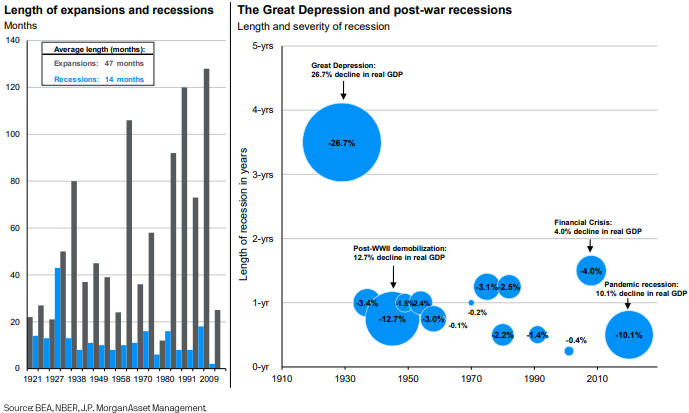Recession talk has been all over the news after the U.S. experienced its second consecutive quarter of negative GDP growth recently. Two quarters of decline has been the shorthand definition of a recession, but there is more to it than that. Officially, the U.S. economy is not considered to be in recession until it is declared by the National Bureau of Economic Research (NBER), a group of economists who look at many different measures such as employment levels, industrial production, retail sales and personal income to make their determination.
It may be that we are currently in a recession despite record low unemployment and increasing personal income. The NBER has been late in declaring the beginning of a recession in the past. Whether or not we are currently in a recession, it is worth looking back to previous downturns to get an idea what the next recession might look like in terms of length and severity.
We use the term business cycle to describe the evolution of the economy over time as it moves from expansion to recession and back again. This term may give the impression that expansions and recessions last roughly the same amount of time and everything balances out in the end. In fact, expansions last significantly longer than recessions as shown in the first panel of the chart below from JPMorgan.

Going back to the early 1920s, the average U.S. recession lasted a little over a year at 14 months. This ranged from the nearly four year Great Depression to the blink-and-you-missed-it three month Covid recession of 2020. The blue bars in the chart show that every recession other than the Great Depression was under 20 months in duration.
Contrast that with the black bars in the chart that show the lengths of U.S. economic expansions. The average length of an expansion is one month shy of 4 years, or nearly four times the length of the average recession. The more than 10-year economic expansion from the end of the Great Recession in 2009 to the Covid crisis of 2020 was the longest expansion on record.
The right side of the chart shows the severity of all the recessions with the size of the circles representing the size of the economic declines. Our last two recessions were relatively large in terms of real GDP decline due to the housing crisis in 2008 and the shutdown of the economy in 2020, but the typical recession (outside the Great Depression) has been milder.
There are areas of overvaluation in the market today that could suffer in a recession. Housing has been rising dramatically, but we are not seeing the kind of reckless lending to underqualified buyers that caused the last housing bubble to burst. The stock market decline this year has brought valuations down close to their historical averages. There is a lack of obvious imbalances or bubbles in today’s economy that need to be deflated and would cause a massive drop in GDP, which leads economists to expect that the next recession will be a milder, more historically average one.
Recessions are never pleasant to live through, but they are relatively short-term events that act as resets for the ensuing, longer-lasting economic expansions. As long-term investors, we have seen many business cycles and believe that holding diversified portfolios of investments can help weather any downturn while enjoying the gains from the return to economic growth.



Social Media